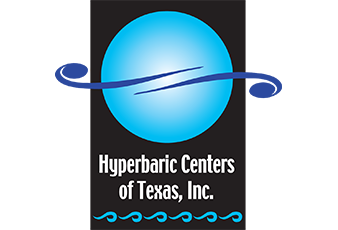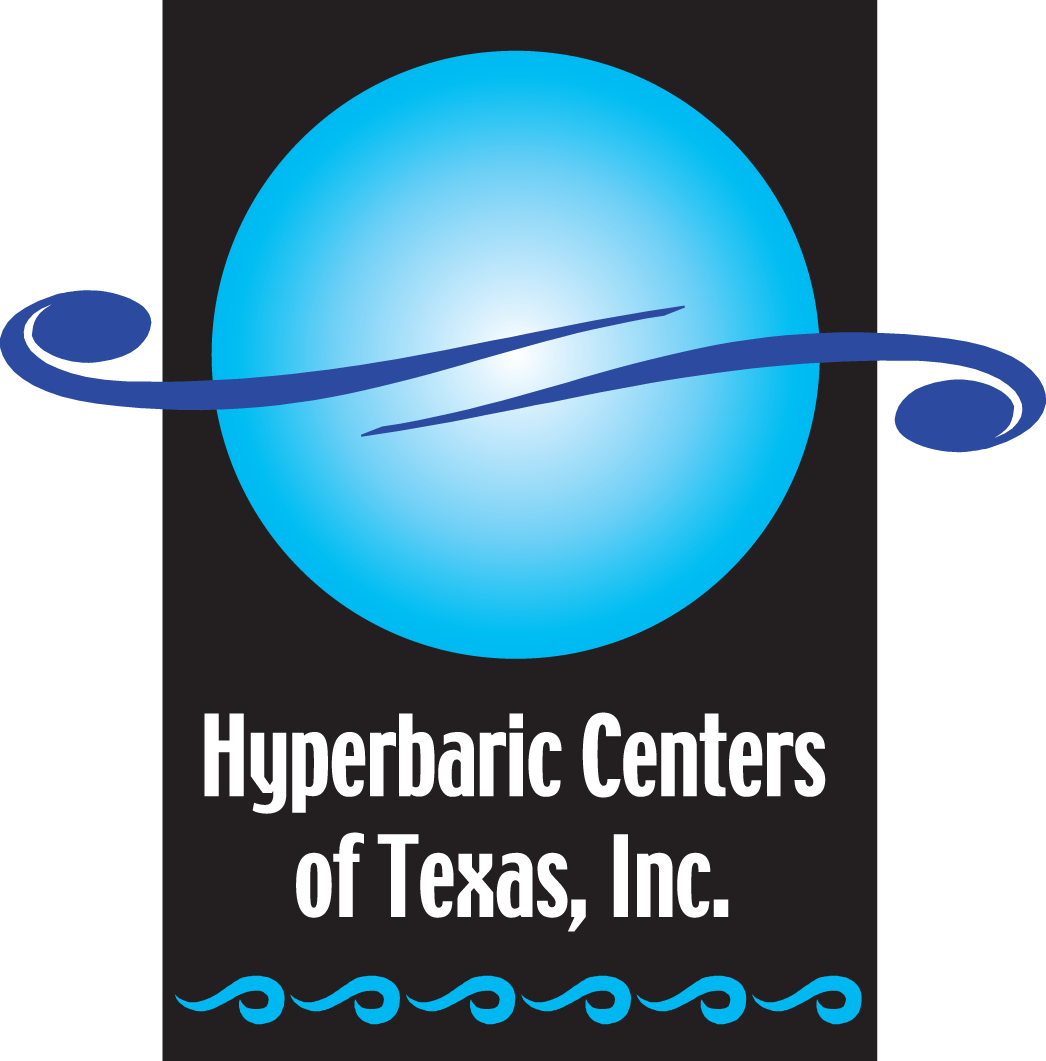You can better understand the concepts behind hyperbaric oxygen therapy (HBOT) by knowing some basic terms:

Glossary
Terminology and Commonly Used Phrases
Hyperbaric Oxygen Therapy
Hyperbaric oxygen therapy describes a person breathing 100 percent oxygen at a pressure greater than sea level for a prescribed amount of time—usually 60 to 90 minutes.
Atmospheres Absolute (ATA in HBOT)
ATA refers to gauge pressure that is true regardless of location. This way, a standard depth can be reached whether located above or below sea level.
Atmospheric Pressure
The air we breathe is made up of 20.9 percent oxygen, 79 percent nitrogen, and 0.1 percent inert gases. Normal air exerts pressure because it has weight and this weight is pulled toward the earth’s center of gravity. The pressure experienced is expressed as atmospheric pressure. Atmospheric pressure at sea level is 14.7 pounds per square inch (psi).
Hydrostatic Pressure
As you climb above sea level, the atmospheric pressure decreases because the amount of air above you weighs less. If you dive below sea level, the opposite occurs (the pressure increases) because water has weight that is greater than air. Thus, the deeper one descends under water the greater the pressure. This pressure is called hydrostatic pressure.
Terms Used to Measure Pressure
There are various terms for measuring pressure. HBO therapy uses pressure greater than that found at the earth’s surface at sea level, which is called hyperbaric pressure. The terms or units used to express hyperbaric pressure include millimeters or inches of mercury (mmHg, inHg), pounds per square inch (psi), feet or meters of sea water (fsw, msw), and atmospheres absolute (ATA).
One atmosphere absolute, or 1 ATA, is the average atmospheric pressure exerted at sea level, or 14.7 psi. Two atmosphere absolute, or 2 ATA, is twice the atmospheric pressure exerted at sea level. If a physician prescribes a one hour HBOT treatment at 2 ATA, the patient breathes 100 percent oxygen for one hour while at two times the atmospheric pressure at sea level.
Other Terminology
A
Aeroembolism — Obsolete term for altitude decompression sickness; also used to mean gas embolism.
Aerobic — Requiring air or free oxygen in order to live.
Air — 79% nitrogen, 20.9% oxygen, 0.1% carbon dioxide and all other gases.
Ambient — Pertaining to the surrounding environment.
Anaerobic — The ability to grow or thrive in the absence of molecular oxygen.
Angiogenesis — The development of blood vessels. Angiogenesis is a major benefit of hyperbaric therapy.
Ascent — Movement in the direction of reduced pressure, whether simulated or due to actual elevation in water or air.
Atmospheres absolute — The sum of barometric and hydrostatic pressures. This is the most commonly used measurement when dealing with hyperbaric oxygen therapy. The abbreviation is ATA.
Atmospheric pressure — The amount of pressure exerted by the weight of the air in our everyday environment. At sea level the pressure of the atmosphere is 14.7 pounds per square inch.
B
Baromedicine — The area of medicine related to physiological processes that occur either from pressure changes or changes in the concentration of inhaled gases.
Barotrauma — The mechanical damage to the tissues caused by unequal pressures.
Bends — An imprecise term denoting any form of Caisson Disease or decompression sickness. It is sometimes a fatal disorder that is marked by neuralgic pains (severe pain along a nerve), paralysis, and dyspnea (difficulty breathing) and is caused by the release of gas bubbles in tissue upon too rapid a decrease in pressure after a stay in a compressed environment. Usually associated with scuba diving.
Bottom time — The amount of time between getting in the water at the start of a dive until the beginning of the ascent.
Boyle’s Law — One of the three gas laws. States that at a constant temperature, the product of the pressure and volume of a given mass of an ideal gas in a closed system is always constant.
C
Chamber — A vessel designed to withstand differential pressures.
- Double-lock — A chamber with two compartments that can be pressurized independently.
- Hyperbaric — A chamber designed to withstand high internal pressures; used in hyperbaric experimentation, diving simulations, and medical treatment.
- Monoplace — A portable one-person hyperbaric chamber used for therapy in a hospital or clinical setting, and for transport.
- Multiplace — A pressure chamber designed to be used by more than one person at a time.
- Single-lock — A pressure chamber with only one pressurized compartment.
Charles’s law — One of the three gas laws. States that for a given mass of an ideal gas at constant pressure, the volume is directly proportional to its absolute temperature, assuming in a closed system.
D
Decompression sickness — A condition caused by too rapid a reduction in pressure; has a variety of signs and symptoms. Synonymous with the bends, Caisson Disease, or compressed air illness. The abbreviation is DCS. Usually associated with scuba diving.
Decompression — In diving, the phase in which the individual is ascending in the water, or in a chamber when the pressure is being lowered.
E
Embolism — Air or gas bubbles in the arterial (artery: a vessel conveying blood from the heart) system caused by gas or air passing into the pulmonary (lung) veins after rupture of the alveoli (air cells of the lung).
G
Gay-Lussac’s law — One of the three gas laws. States that for a given mass and constant volume of an ideal gas, the pressure exerted on the sides of its container is directly proportional to its absolute temperature.
H
HBO — Common abbreviation for hyperbaric oxygen. HBO is the use of increased oxygen concentrations under greater than normal atmospheric pressure.
Hydrostatic — Relating to the pressure that liquids exert.
Hyperbaric oxygenation — Also known as hyperbaric oxygen therapy. The use of an oxygen breathing mixture where the ambient pressure is greater than 1 atmosphere. This is abbreviated as HBO or HBO2.
Hyperbaric — Pertaining to pressure greater than one atmosphere.
Hyperbaric pressure — Pressures greater than atmospheric pressure.
Hyperoxia — An excess of oxygen in the body tissues produced by breathing a mixture in which the inspired (inhaled) oxygen pressure is greater than its partial pressure in air.
Hypoxia — Oxygen deficiency.
I
Ischemia — Local reduction of blood supply due to obstruction of inflow of arterial blood.
M
Microaerophilic — Requiring free oxygen for growth, but thriving best when the oxygen is less than the amounts in the atmosphere.
Monoplace chamber — A HBO chamber designed to hold one person, usually at a maximum pressure of 3 ATA.
Multiplace chamber — A HBO chamber designed to hold two or more persons, usually with pressures of up to 6 ATA.
O
Osteomyelitis — Inflammation of the marrow of the bone.
Osteonecrosis — The process of bone cells dying in mass.
- Dysbaric — Changes in structure of bone in which the relative density of the affected bone is increased by sclerosis (hardening). Observed changes are the result of a healing process following insult (trauma). Found in caisson workers and more recently in divers, and probably due to inadequate decompression. Synonymous with aseptic bone necrosis and avascular bone necrosis.
- Juxta-articular — Osteonecrosis occurring near the joint articulation, usually hip or shoulder. May lead to collapse of the joint, together with pain and dysfunction.
- Medullary — Osteonecrosis occurring in the shaft of the bone, usually without symptoms and detected by x-ray.
Otitis — Inflammation of the ear, which may be marked by pain, fever, abnormalities of hearing, tinnitus (ringing in one or both ears), and vertigo (dizziness); a problem possible with diving or HBOT treatments.
Oxygen poisoning — Deleterious (harmful) effects caused by breathing high partial pressures of oxygen. Prolonged exposure can result in effects which become progressively more severe as the inspired partial pressure and/or the duration of exposure increases. Depending on level and length of exposure, may cause lung damage; involvement of the central nervous system can cause convulsions or early death.
Oxygen toxicity — Physical impairment that results from breathing pure oxygen for prolonged periods of time; the time to achieve toxicity is shortened as the pressure in the surrounding environment increases.
P
Pressure
- Absolute — The sum of all pressures acting on an object; in diving, the sum of the atmospheric (air) pressure and the hydrostatic (water) pressure acting on a submerged object.
- Ambient — The absolute pressure surrounding an object.
- Atmospheric — Pressure exerted by the earth’s atmosphere, which varies with altitude above sea level. At sea level, atmospheric pressure is equal to 760 mmHg or 1.03 kg/square centimeter, or 14.7 pounds per square inch.
- Hydrostatic — The pressure of a column of water acting upon a body immersed in the water, equal in all directions at a specific depth.
Pressurize — To increase the internal pressure of a closed vessel.
T
Treatment depth — The depth or pressure to which a patient is compressed for treatment.

